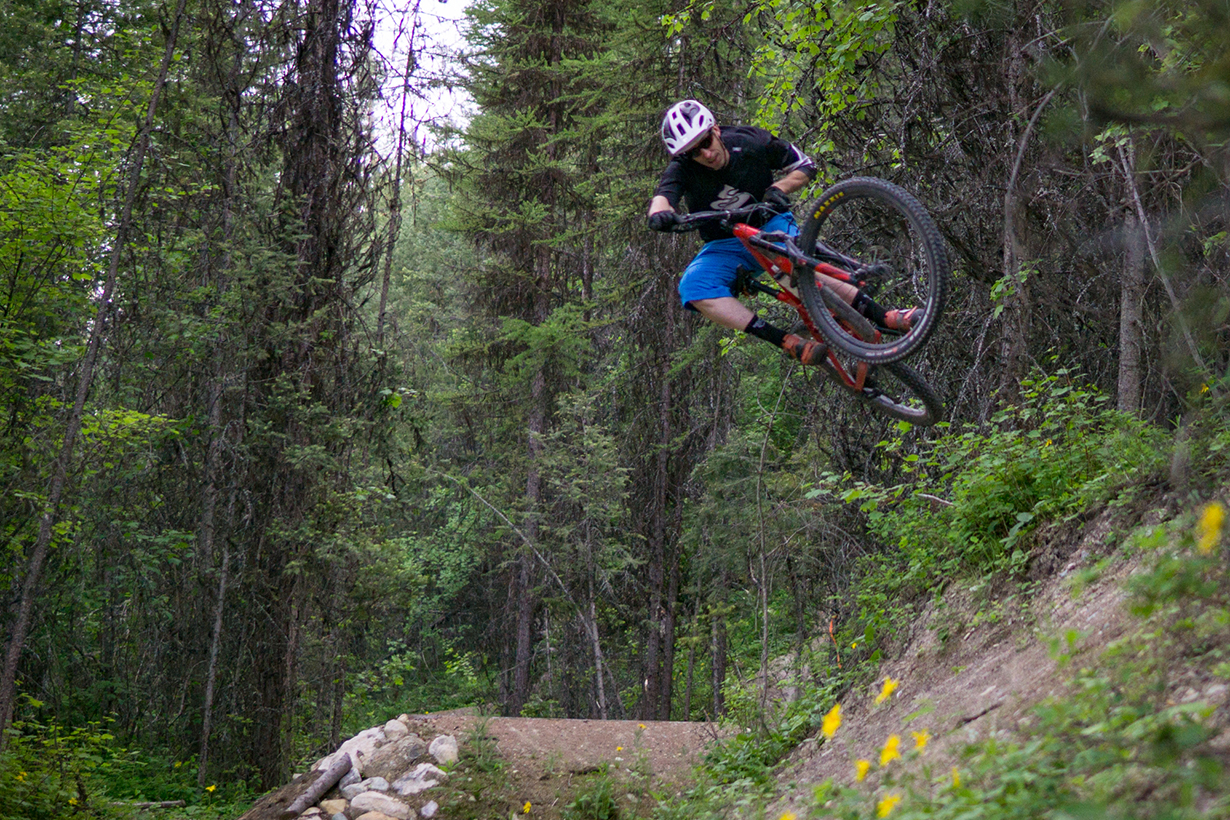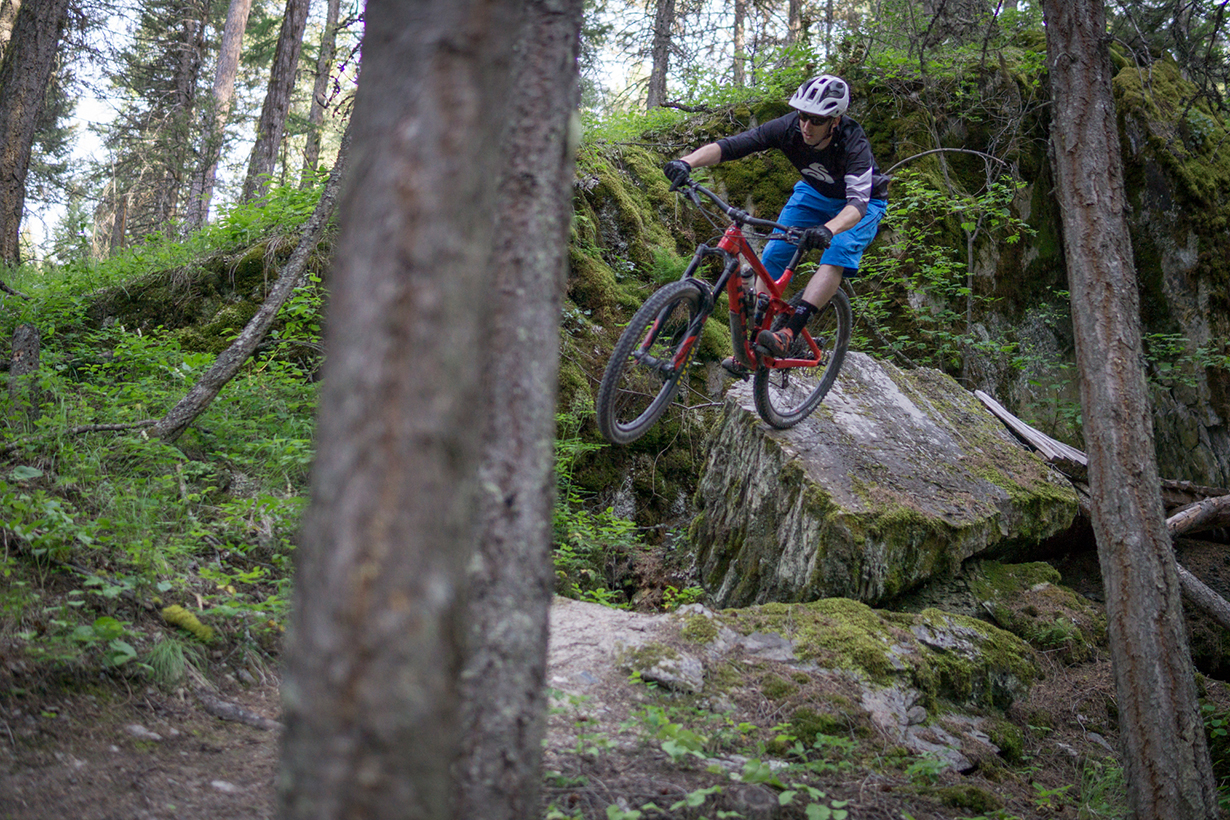The Build
The Remedy 9 RSL is built around a mix of Sram / Rockshox parts, and in-house Bontrager branded parts (Trek owns Bontrager, for anyone who missed that memo). Generally speaking, I found the build to be pretty intelligent, and there weren’t any parts that were screaming to be replaced right away.
The drivetrain is Sram X1 11 speed, although it gets a downgraded GX cassette. I’ve spent a ton of time on X1 drivetrains (and GX cassettes) over the past two years on a couple different bikes, and while it doesn’t quite have the crisp shifter action of X01 or XX1, it has worked really well for me and held up well — no complaints there.

Braking is also handled by Sram, with Guide RS stoppers paired with 180 mm rotors. I’m a fan of the fact that Trek didn’t downgrade to the Guide R’s — the SwingLink levers (the “S” in the RS) offer far better modulation. And for 2017, all Guides have Sram’s new Bleeding Edge system, which means that I have to buy a new bleed kit, but it also means that bleeds are easier to do well.
But it’s the suspension that sets the Race Shop Limited build apart from the “regular” Remedy — the RSL gets a 160 mm Rockshox Lyrik rather than the lighter-but-less-burly 150 mm Rockshox Pike on the non-RSL versions. The Lyrik is a bigger, stiffer, heavier fork, and it rides a good bit differently than a Pike due to a huge negative air chamber. Basically, that means the Lyrik is ridiculously supple at the beginning of its stroke, and it feels far closer to a true downhill fork when smashing through rough trails. The Lyrik that comes on the RSL is also the Dual Position Air version of the fork, which means you can drop the travel from 160 mm down to 130 mm with a quick turn of a dial. Personally, I find that I almost never use the travel adjust feature, so I’d rather have the simplicity and lower cost of the DebonAir model. But I’m sure some people will appreciate the ability to drop the front end a bit on climbs.
On the back, suspension is handled by a Rockshox Deluxe RT3, which has Trek’s proprietary RE:aktiv tune (which also means, annoyingly, that it also comes in Trek’s proprietary size that’s tricky to replace). At its heart, the shock is just a Rockshox Deluxe with the normal external adjustments — a three position open / pedal / lock lever, and a rebound knob. But the RE:aktiv tune is quite a bit different from “normal” Rockshox shocks, and the difference has a pretty significant impact on how the Remedy rides.
Rounding out the Remedy’s build spec is a slew of Bontrager parts. The Remedy rolls on Bontrager Line Comp 30 wheels shod with 2.4” Bontrager SE4 tires, which come ready to be set up tubeless. The Line Comp wheels leave a little to be desired; they’re certainly not the stiffest around, and the rim material seems to be pretty soft. I put a few solid dents in them on seemingly minor impacts. The Bontrager hubs are also underwhelming; the rear was prone to skipping, and the front lacked torque caps to interface nicely with the Lyrik.

I got along reasonably well with the Bontrager SE4 tires, although the casing is a bit light for what the Remedy is capable of, and I pinched the tire in a few spots. That aside, I’m a fan of the tread pattern for use in the rear, but I found myself wishing for a non-DH casing version of the Bontrager G5 for use in the front.
A Bontrager bar and stem get the job done, and Trek gets at least a moderate amount of kudos for spec’ing a wide-ish 780 mm bar, although the rise and sweep of the bar took a little getting used to.
And last but not least is the Bontrager Drop Line dropper post. So far, it’s functioned pretty well, and I like the under-bar remote for it. It has more rotational play than I’d like, it doesn’t quite get the full 125 mm travel as advertised, and it can get a little sticky when muddy. But it hasn’t broken or failed in any way, so really, no major complaints there.
NEXT: Fit and Geometry, Performance, Etc.

Great, detailed (yikes!) review on a great bike, Noah. I’ve got the predecessor in 29 and love it. Kinda hoping Trek adds that model next year.
I’ve also got a 2016 Fuel EX that I use for endurance racing (disclosure — Trek helps me out in this regard). I’ve been pounding this bike for nearly two full seasons (including a few laps up, over and around Tally Mountain in your back yard). A few observations on both bikes FWIW:
1. Love the water bottle capability. Both of mine (21 or 21.5) will hold a one-liter Zefal Magnum bottle. Heaven!
2. I’ve never had FS bikes with longer lasting, quieter pivots. On new bikes, I pop out the seals from each bearing, and top them off with Dumonde Tech liquid grease. Never had a peep from either bike, going on two seasons for the Fuel EX and three seasons for the Remedy.
3. The Reaktiv rear shocks are everything they are cracked up to be for trail riding. Like a Brain that works right. For actual racing, I use a shock with firmer lockout valving for the inevitable gravel road climbing sections in just about every endurance race.
4. As an old school guy, I wondered about the integrated lower headset bearings. Turns out to be a non-issue, and the Remedy has seen a LOT of rugged, rocky riding.
Amazing review. Extremely detailed and well thought through.
Noah — thank you for the detailed review. I have been looking at buying the Fuel EX 9.8 and was wondering how much I could infer from your review of the Remedy in considering the Fuel EX? In general the review seems very favorable of the Remedy and trying to ascertain if you were to review the current Fuel EX if you would reach similar conclusions. I know it’s a difficult question to answer but hoping for some guidance. I’m coming off of a 10-year old 26″ Santa Cruz Superlight and would like to upgrade. I’m a little cautious of going all the way up to a 29er vs. a 27.5, but I like the components on the Fuel EX 9.8 and some of the common characteristics of the Remedy in your review hit home with me. I live in Marin County and truth be told do most of my riding on fire roads, although I plan to increase riding of single tracks. A local bike shop in Fairfax is really pushing the Norco Optic 9.2 or 7.2, but I haven’t seen any recent reviews of Norco to assess.
Love your reviews and keep up the great work. I hope Jonathan is healing well!
Thanks,
Jim
Great review